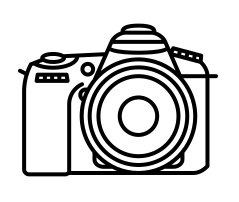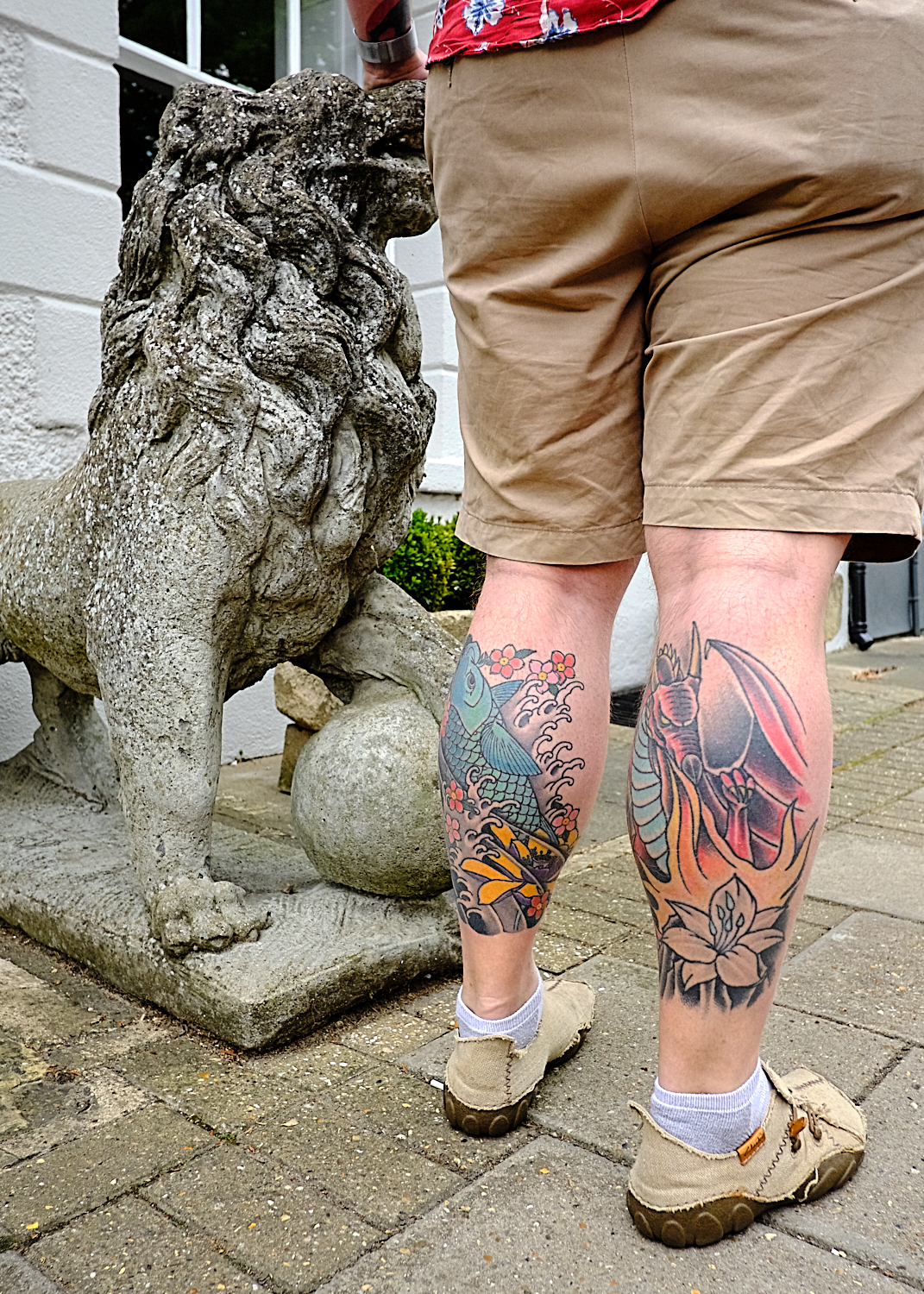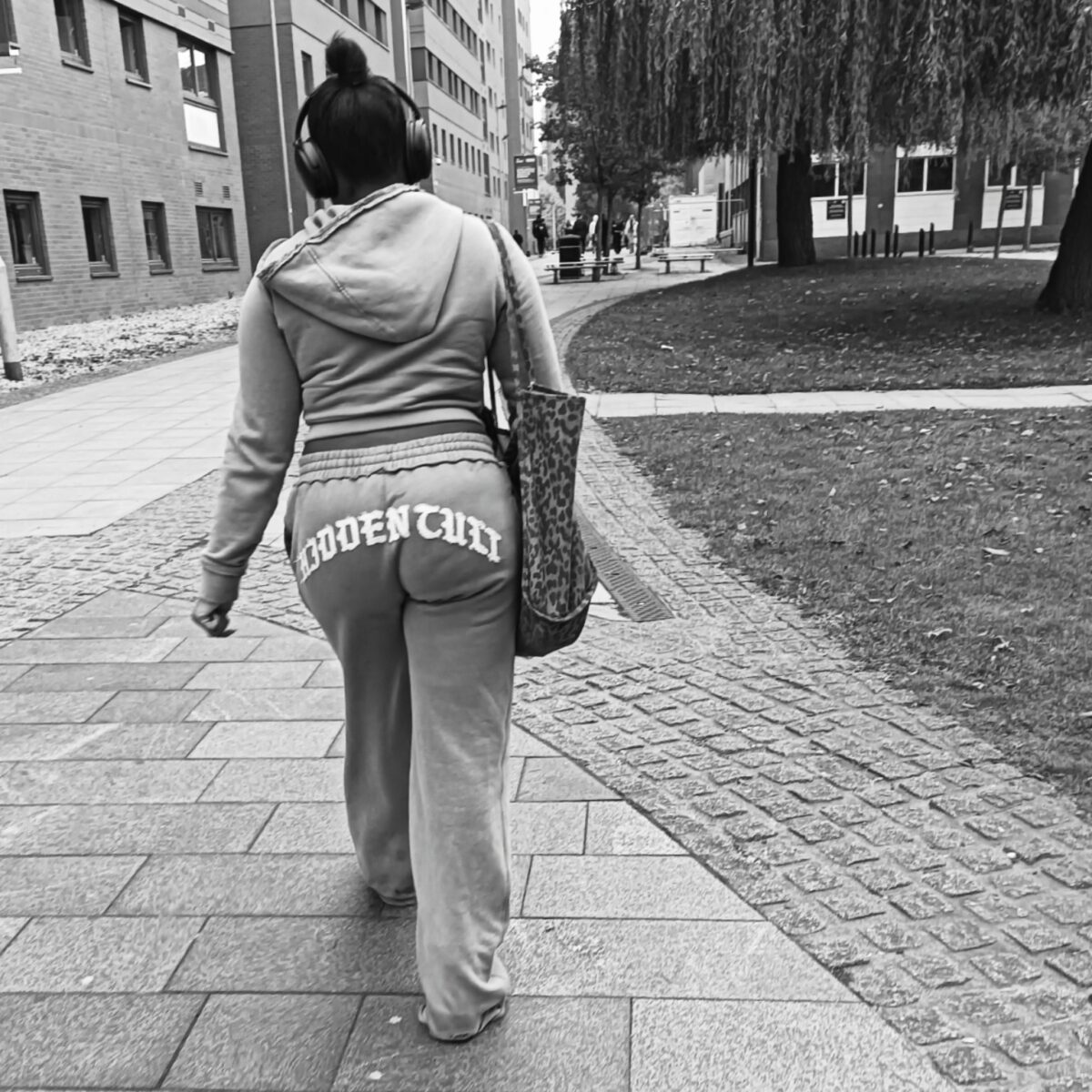Seeing the Tattooed Body: Meaning, Gaze, and Co-authorship
This street photograph shows the back of a figure standing: shorts, trainers, the calves fully visible. Across those calves, vivid tattoos – one a koi fish, the other a lotus flower and possible dragon form – announce themselves in colour and detail. The photographer and subject are strangers; the image is candid. Yet this moment brings into focus a complex web of meaning that stretches beyond the skin. From psychological, sociological, anthropological, and spiritual perspectives, the tattoos form a lifelong narrative. The photograph adds another layer, transforming private expression into public representation.
The Tattoo as Lifelong Narrative
Tattoos function as enduring self-portraits written on the body. They are visual stories of identity that carry forward through time. In this image, the motifs of koi and lotus carry dense symbolic histories. In East Asian myth, koi swim upstream and, by leaping the Dragon Gate, transform into dragons – symbols of perseverance and triumph over adversity (MeaningTattoo, 2024). The lotus, growing unsoiled through mud, symbolises spiritual purity and renewal (GiobelKoiCenter, 2024). When joined, these forms articulate a story of struggle and awakening: I have endured; I continue to rise.
Psychologically, this translates into an externalised self-narrative. Oksanen and Turtiainen (2022) note that tattooing allows individuals to claim agency over their bodies and construct coherence between inner life and outward form. The act of inscription fixes a version of the self that feels authentic and stable. The pain and permanence of tattooing transform memory and emotion into tangible marks – each a small rehearsal of endurance.
The calves as location add nuance. Legs are mobile, active, and visible in casual settings yet concealable elsewhere. By placing tattoos there, the wearer literalises movement through time: the marks travel wherever the body goes. In that sense, the tattoos are psychological anchors – reminders of resilience and personal continuity, moving with every step.
The Body as Cultural Text
Anthropology reminds us that the tattoo is never purely individual. Across cultures, tattoos have served to signal belonging, passage, and moral codes (Datta, 2023). What was once a rite or protection mark has become, in modern societies, a medium for self-expression that still echoes collective ritual. The act of being tattooed involves the same ingredients found in sacred initiation – pain, transformation, permanence, and social display. The subject’s tattoos may not mark entry into a tribe, yet they still index a change of status: from one life chapter to another.
The motifs themselves represent cultural borrowing. Western tattoo culture frequently adapts Japanese and Chinese iconography, often detached from its original religious context but still carrying connotations of wisdom, strength, and spiritual depth (Gallardo, 2023). This global circulation of symbols means that even personal tattoos participate in transnational flows of meaning. The wearer inscribes a cross-cultural narrative onto their skin, making the body a living site of translation.
For anthropologists, this is typical of post-industrial societies where the body replaces older religious or communal structures as the main site for declaring value and belonging (Datta, 2023). To tattoo the body is to write oneself into a wider symbolic economy – part fashion, part faith.
Negotiating Visibility
From a sociological perspective, tattoos are both self-expression and social signal. Goffman (1959) described everyday life as theatre, where identity is performed for an audience. Tattoos complicate this performance because they are semi-permanent props: they speak even when the actor is offstage. Leg placement demonstrates social calculation. A visible but concealable tattoo allows the wearer to manage stigma and acceptance simultaneously.
Studies of “job-stopper” tattoos show that visibility is tied to employability and respectability (Gallardo, 2023). Choosing the calf permits flexibility – the tattoos can be seen in leisure contexts but hidden in formal ones. This is an act of impression management: balancing authenticity with social mobility. The message becomes: I am distinct, but I know the codes.
Sociologically, such markings also signal class and belonging. Once associated with deviance, tattoos now cross class lines yet retain traces of rebellion (Oksanen & Turtiainen, 2022). Large, colourful designs like these still announce independence, taste, and self-investment. The wearer is saying: I own this story and the space it occupies.
The Spiritual Undertone
The koi and lotus are not just aesthetic. Their pairing often gestures to spiritual or philosophical ideas of transformation through struggle. The koi’s ascent into a dragon mirrors the Buddhist notion of samsara – progress through cycles of difficulty toward enlightenment – while the lotus mirrors purity emerging from suffering (GiobelKoiCenter, 2024). To carry these symbols on the legs may suggest a spirituality grounded in movement and action rather than doctrine.
Spiritual tattoos operate as constant rituals of remembrance. Each time the wearer looks down or catches their reflection, the imagery reactivates meaning. Over time the tattoo functions less as decoration than as mantra. In this light, tattooing becomes a lived spiritual practice – an embodied meditation on persistence and becoming.
The Observer’s Gaze
Every visible tattoo presumes an observer, but the street photograph changes that relationship. The image was unplanned; the photographer and subject are strangers. Yet by selecting this frame – the rear view, the calves, the ink – the photographer constructs a new narrative. They turn the personal symbol into a public text.
Here Goffman’s (1959) analysis of the “presentation of self” is useful again. The subject’s everyday act of dressing and walking is a performance directed at an immediate social audience – people in the street. The photographer’s lens extends that audience indefinitely. Once captured, the tattooed body enters what Cooley (1902) called the looking-glass self: our awareness of ourselves as seen through others’ eyes. The photograph multiplies those eyes.
Psychologically, this introduces what might be called representational displacement. The tattoo, once under the wearer’s control, now circulates without them. Viewers of the image interpret character, story, or intent based on composition, lighting, and cultural bias rather than lived context. The subject’s self-presentation joins a network of interpretations they cannot manage. In Goffman’s terms, the performance continues long after the actor has left the stage.
Sociologically, this is the condition of modern identity: part self-authored, part crowd-sourced. Every image contributes to a public archive of selves where meaning migrates from person to representation. The candid photograph crystallises this process. Even a momentary click of the shutter redistributes authorship – turning the wearer’s private mark into shared cultural currency.
The Photographer’s Role
Though unplanned, the photographer becomes a co-author in meaning. They do not alter the tattoo but they decide what the world will see of it. By choosing a rear-view composition, they direct attention to the legs as visual text, framing the tattoos as the photograph’s subject. In doing so they translate the body from lived presence into symbol. Banks (2015) argues that photography always mediates between observer and observed, creating social knowledge through selection and framing. The photographer here participates in that process: editing the world into an image that invites contemplation, aesthetic judgment, or moral reading.
This co-authorship is asymmetrical. The tattooed person writes the first text; the photographer writes the second. The first is autobiographical; the second, interpretive. Yet both rely on visibility and curiosity. Street photography, like tattooing, depends on exposure – the willingness to let oneself, or one’s subject, be seen.
Afterlife of the Image
Once shared or exhibited, the photograph grants the tattoos a second biography. The original act of self-marking was permanent but personal; the photograph makes it permanent and transferable. For photography students, this raises ethical and creative questions. When capturing strangers, we are not just documenting; we are reframing their self-expression. The resulting image belongs both to the world of art and to the life of the person who never chose to be its subject.
In this tension lies the beauty and responsibility of the medium. The camera, like the tattoo needle, inscribes meaning on a surface – but here the surface is social. Each image re-authors reality, joining an unending exchange of gazes where identities are made and remade.
Running through my head
As I said on the other image, when I feel drawn to make one in the street it is rarely for ‘artistic’ purposes. I’ve usually seen something unusual, a load of questions are firing off in my head, and the image is to be a prompt for me to reflect on later as I won’t usually get a chance to have them answered at the time.
I saw this individual, who had just left a Chinese Restaurant standing saying goodbye to two friends. I guessed that they would break up soon. He was propping himself on the lion, and it was the triptych with his tattooed calves that caught my eye. Three SE Asian symbols aligned. I realise that it isn’t a perfect aesthetic, but it was the symbolism that fascinated me. Tattoos are permanent and, when they are as fine as these, I’d imagine that there’s a lot of consideration gone into their selection. The questions rushing through my head mostly reflected this and, unlike the previous image weren’t particularly ‘profound’.
WHAT DO THEY SYMBOLICALLY REPRESENT? I could see that they had a common SE Asian theme, and I know that in those cultures there’s a lot of meaning attached to such designs.
WAS THE SYMBOLISM TRULY RELEVANT TO HIM OR HAD HE JUST APPROPRIATED IT?
WHAT IS/WAS GOING ON FOR THIS GUY? Tattoos often reflect letting go of a past and aspiring to a future. I wondered what his story was.
WAS THERE SOME KIND OF CONFLICT BETWEEN WHAT HE WANTED TO SAY AND WHAT HE FELT HE COULD SAY? The back of the legs can easily be covered, and he looked as though he was a young professional. Had he felt he had to conform to some social ‘norms’?
HOW WOULD I EXPLAIN MY CURIOSITY AND BEHAVIOUR? They didn’t look threatening, but I knew that I couldn’t get the picture without them seeing me.
I knew I needed to act quickly. I approached fast, dropped to my knees and took the picture right behind him. The friends clearly saw me and reacted – he tensed, but hadn’t realised what was going on. Maybe that tensing was what gave one of you the impression that it was staged? Afterwards, we all had a laugh, he was flattered, answered some of my questions, and I left.
References
Banks, M. (2015). Visual methods in social research (2nd ed.). Sage.
Cooley, C. H. (1902). Human nature and the social order. Scribner’s.
Datta, S. (2023). Socio-cultural significance of tattoo from anthropological perspectives. Skylines of Anthropology, 1(1), 28–35.
Gallardo, R. (2023). Avoiding the “job-stopper” tattoo: Placement and social negotiation. Journal of Contemporary Sociology, 12(2), 45–62.
GiobelKoiCenter. (2024). Koi fish and lotus flower tattoo meaning. Retrieved from https://giobelkoicenter.com
Goffman, E. (1959). The presentation of self in everyday life. Doubleday.
MeaningTattoo. (2024). Koi fish tattoo symbolism. Retrieved from https://www.meaningtattoo.com
Oksanen, A., & Turtiainen, J. (2022). Tattoo narratives and embodied identity: Agency through permanence. Body & Society, 28(3), 22–45.


